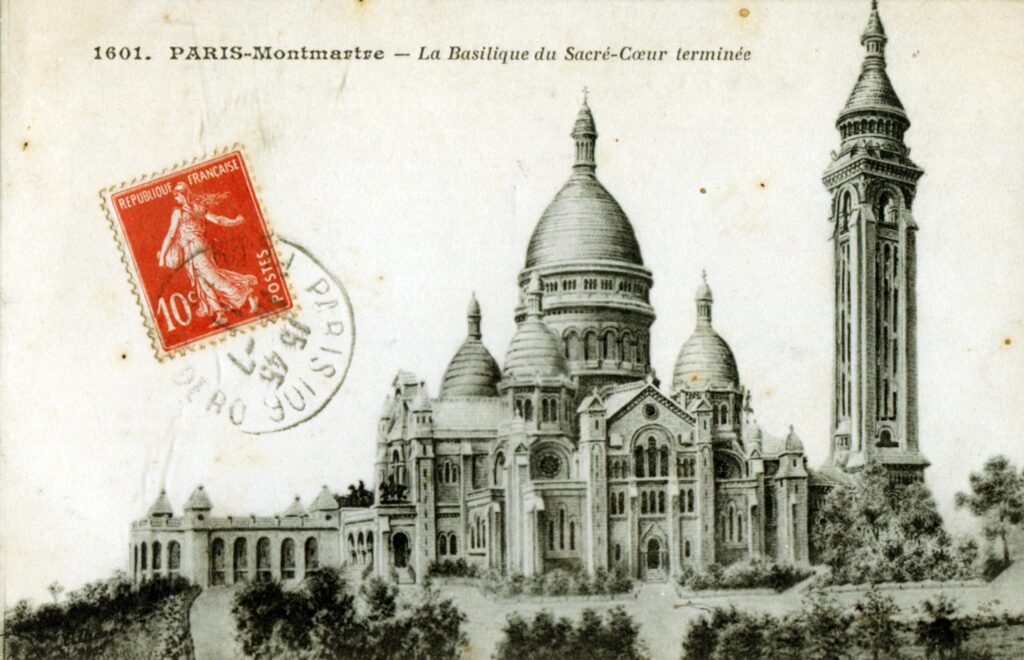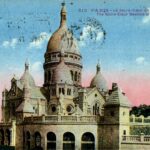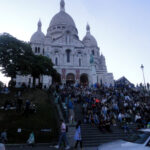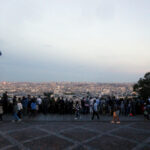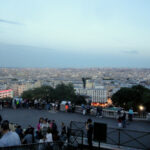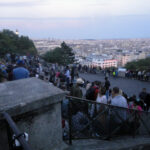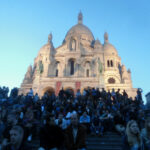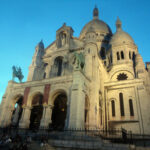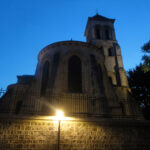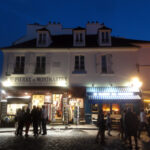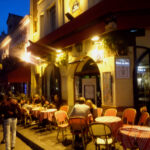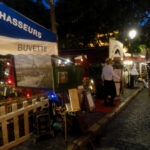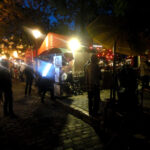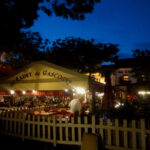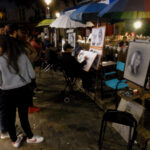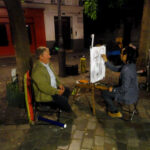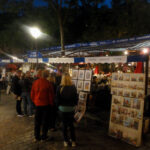Montmartre is a whole town with its own life, its museums, cafes and restaurants, artists, regulars and even a grape plantation. In each of its places you can stay for several hours.
A tour of Montmartre helps you understand where everything is, so that later you can come here on your own many, many times. The guide will also tell you about the main historical events associated with this “Hill of the Martyrs” and about famous people whose life and work took place in this area of Paris.
There are many options for the routes and the starting points, below we present the “classic” version.
Montmartre walking tour in Paris with a private guide or by yourself
Self-guided or guided Montmartre walking tours start at the Anvers metro (Route 1).
When the Russians took Paris in 1814, the city limits passed here, and Montmartre was a natural fortified area on the outskirts of the capital. At one of the mills, the defending French “militias” sat, whom the Russian troops destroyed. In memory of this, the term “Moulin Rouge” appeared, it is also “red mill” or “bloody”. But the Hill received its name of martyrs from another legend about Bishop Dionysius, who was once executed here, later canonized as a Holy Great Martyr.
For a long time, this outskirts of Paris was an industrial area for the extraction of gypsum and limestone. It is possible that the presence of such raw materials once began to attract sculptors, artists and creative craftsmen here. It is known for sure that artists began to massively settle in Montmartre at the end of the 19th century. In those days they were still poor and little known, but some of them later became Great. First of all, Van Gogh, Picasso, Toulouse-Lautrec, Modigliani and others. After the First World War, all this bohemia moved to Montparnasse, and at the beginning of the 20th century, the entire art community was located on this Hill. In addition to artists, famous writers lived and worked here, such as Victor Hugo. Revolutionaries and members of opposition parties to the Tsarist Russian government also lived in these streets, including the legendary Boris Savenkov.
Until now, this area is considered bohemian-elite, and throughout the 20th century there was a fashion center and goods for fashion designers. If we stand, as we start the tour at the Anver metro, facing the top, decorated with the Sacré Coeur, then ahead we see the tourist street Rue de Steinkerque. Now there are souvenir shops on every corner. And 15 years ago, there were shops with fashionable fabrics and products for tailoring fashionable clothes. Paris was and is the trendsetter of world fashion, but housewives have already forgotten how to work with their hands on the Singer sewing machine. All this has already gone down in history. And what elegant, expensive and not very fabrics were here: silk, cloth, drape, velor of all colors, beautiful buttons and elegant zippers. The wives of tourists who came here spent the whole day walking around these shops to buy everything they needed and sew at home on some Veritas sewing machine for themselves a super fashionable dress. But the 90s passed, our women began to buy ready-made dresses on the Champs Elysees or in the Galeries Lafayette, and fashion fabric stores that could not withstand the competition and lost sales went down in history. But even now, whoever is interested, may not go straight up to the top of the hill, but go around the streets to the right, parallel to the tourist route and see the remnants of the old fashion. The owners of shops in the old fashioned way sit at the remnants of unsold fabrics, leather, zippers and apparently recall the recent past. Tourists do not go here and shops are closed every year. But it is these streets just to the right of the mass route that will help you feel the atmosphere of real France of the 20th century, old and good. Looking ahead, let’s say that if you go from Anvers to the left to the Pigalle metro station, there is the same situation with musical instruments.
But now we are going up from Anvers to the funicular and admire the grandeur of the Sacred Heart Cathedral. We are traditionally pestered by Afro-French people with a bunch of mini-Eiffel Tower souvenirs, or with offers to play a game like “thimbles” from the 90s we have forgotten. Your guide only needs to look at them to leave you alone.
- Sacred Heart (Sacré Cœur)
You can ride the funicular upstairs, or you can climb a long steep staircase, instead of working out in the gym. Immediately upon exiting the elevator cabin, an observation deck begins, where they again begin to offer you all sorts of unnecessary knick-knacks.
From here you can admire Paris from a height of 130 meters (!). There are always a lot of people, noisy and fun. Traditionally, champagne pops and even Russian speech is heard. Small telescopes have long been installed to view the buildings of Paris in detail, but few people use them. The tour, as a rule, takes place during the day, and in the evenings they return here on their own, not forgetting to “stock up” at the foot of the Arab store with a “gentleman’s set” of French wine, glasses and light snacks. Especially for this, there are benches and steps with nooks for various small companies.
There are always people at the entrance on the steps of the Sacré Coeur (“Sacred Heart”) Cathedral. Inside the white-stone Temple, the organ sounds during the service. The height of the Basilica is such that it dominates the city and can be seen from afar. Outside, young people are walking on the site and music is playing, sometimes live in the form of the wandering artists.
The basilica is worth going around from different angles and admiring its complex architecture. The tour goes to the left, where the old streets begin with no less old cafes and restaurants. The center is Place du Tertre. Once upon a time there was a gloomy court here and even criminals were executed, but now the whole space has been occupied by artists who paint portraits, cartoons, views of the city in any manner and style. They are surrounded by cafes – restaurants with excellent French cuisine, where you can eat well and drink it all with wine, and in winter with freshly brewed mulled wine. Some restaurants look like mini-museums with various artifacts and commemorative plaques. But there are also several real museums included in all lists recommended for tourists to visit.
Corner House N11 on Rue Poulbot is the Salvador Dali Museum. A little further away, in the beautiful Renoir mansion, there is the Montmartre Museum. Van Gogh, Paul Gauguin, Emile Bernard and other celebrities lived here.
Near the Montmartre Museum, at the intersection of Rue des Saules and Rue Saint Vincent, real vineyards have been preserved. They are said to be the oldest in Paris. Every year this gives a good occasion at the beginning of October to “celebrate” the “harvest” holiday. Behind the grape plantation is the oldest cabaret, Le Lapin Agile, which is easily recognizable by its funny sign with a rabbit that stole a bottle and escapes from a boiling pot. This is a Montmartre cabaret with a lot of history. Next – the wall of the cemetery of St. Vincent, where the artists Steinlein, Utrillo and the writer Marcel Aimé are buried.
The north side of Montmartre is a real non-tourist Paris of the French with old buildings and small stairs. But we will turn the other way, towards the “Moulin de la Galette” along Rue Lepic. Once there were windmills in these parts, but only one has survived to this day, which is a monument of architecture and engineering. She was immortalized in his work by Renoir in the painting “Ball at the biscuit mill” (now in the Musée d’Orsay).
The Moulin de La Galette is also a restaurant with an old style, which is also actually a museum, where visitors can easily see this historic mill up close. In the time of Napoleon, they did not use the funicular and got to the Basilica along the long, gently sloping Lepic Street, formerly called Imperial. Later it was renamed in honor of General Leppik, who was responsible for the defense of Montmartre from the Russians 🙂 in 1814. The area is already quiet and there are no hordes of tourists. Ordinary Paris of the 20th century with its bakeries and shops. If you go down the Rue d’Orchampt to the Place Emile Goudeau, then we get to Bateau Lavoir, the former Parisian hostel of artists, where Picasso and Modigliani lived. Go down Rue Ravignan to Rue Abbesses and on the right at 154 Rue Lepic you will see where Vincent van Gogh lived. Rue Tholoze continues to operate the Studio 28 cinema, opened in 1928 in the former Fiacre theater building.
Joseph de Maistre Street leads to the Montmartre Cemetery (Cimetière Montmartre), little known to tourists. It was founded at the end of the 19th century on the site of a former gypsum quarry and was intended for the poor. Over time, it turned into a well-maintained park-like place with highly artistic crypts and burial places of famous people: Ampère, Stendhal, Heinrich Heine, Emile Zola, Jacques Offenbach, Berlioz, Dalida, etc.
If you go down to the Boulevard de Clichy, then you will find yourself on the southern border of the hill. White Square (Place Blanche). From here, during the years of the German occupation, the White Army Russian officer Lopatinsky and his son accompanied the Soviet prisoners of war who had escaped from the camp to the French partisans. But the area is so called because of the color of the gypsum, which was mined in this place. Back in 1889, the world-famous Moulin Rouge cabaret was opened here. On the other side of the square, closer to the center, there are music schools, shops and all the goods for musicians. This is also a tradition of Montmartre and Paris. Bohemian area for bohemian musicians. And it also becomes a thing of the past, as there are fewer and fewer purchases in them. Having wandered around the area of music stores, you yourself will become a witness to the story, telling in the future “..But I saw this area when musical instruments were sold here.”
The boulevard from Blanch to Place Pigalle has a reputation for “reduced social responsibility,” in the president’s words. The Red Light District with numerous sex shops and strip show windows. On seven floors in the house N72, the erotic museum has spread its “exposition”.
After passing through the “such” area, the tour ends at the Pigalle metro station.
Self-guided walk through the evening Montmartre in June 2017
For an initial acquaintance with the Montmarte area and its main attractions, tourists prefer a daily self-guided walking tour or with a professional guide. After that, later, you can go for a walk here in the evening, sit in a restaurant, taste French cuisine and wine, or even commission your portrait to a local artist. Below we show a small photo gallery, as it usually happens.
In 1814, Montmartre was a real battlefield, the soldiers of the allied forces, the Russian army and Cossacks, French soldiers and local residents died. You can commemorate all the victims of this war, first in the Cathedral, and then, according to the military tradition, with a glass of wine in cafe.
- Tourists sit on the stairs
- Observation deck at evening Paris
- Observation deck
- Tourists sat on the steps
- Basilique du Sacré Cœur
- The Sacred Heart Basilica
- Sculpture with a horse
- Old church nearby
- Souvenir, watercolor and painting shop
- Cafes and restaurants
- Cafe and Tertre square
- Square on the other side
- Cadet de Gascogne
- Gallery of professional artists, bohemia
- The artist at work, painting a portrait
- Original drawings – the best souvenir from Paris
Before walking around Montmartre, we also recommend booking a private sightseeing guided tour of Paris by car, from your hotel or directly from Charles de Gaulle (Orly, Beauvais) airport. If you have already visited Paris, then we have special programs for “advanced” tourists, for those who want to improve their knowledge of France and Paris.
For those who are interested in military history and battlefields. We recommend visiting the Army Museum (Les Invalides), which shows the war of 1814, including in Montmartre.

